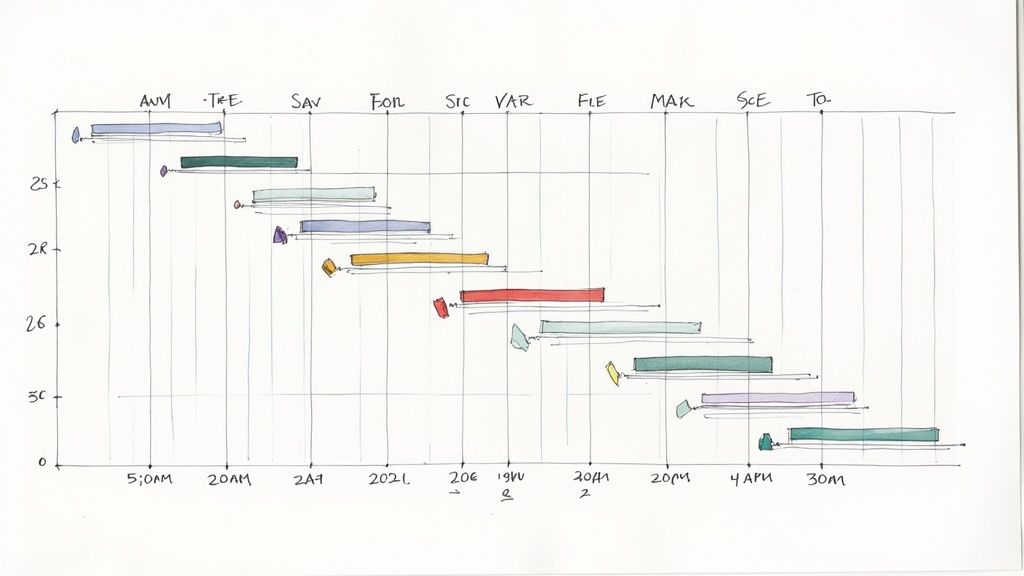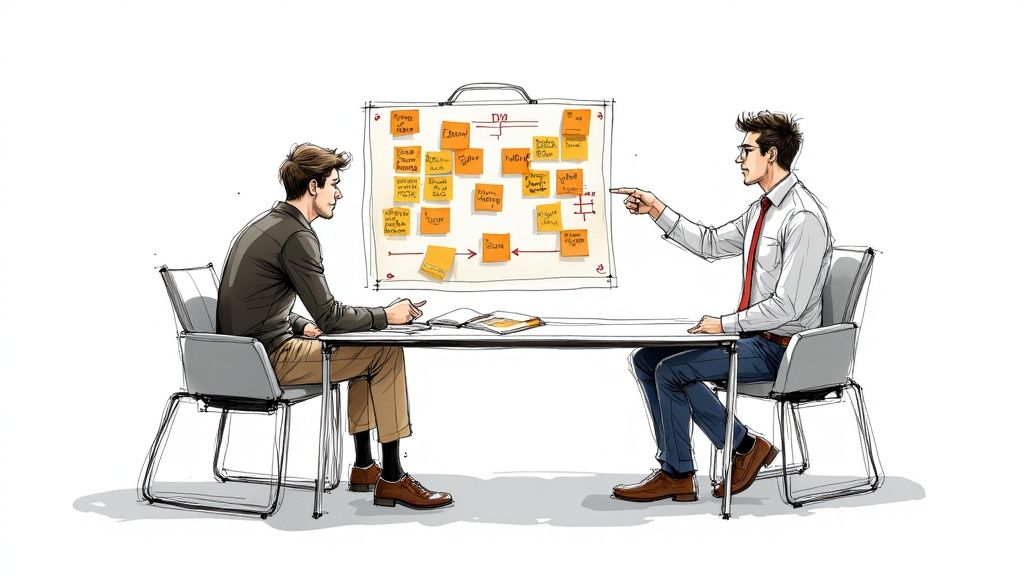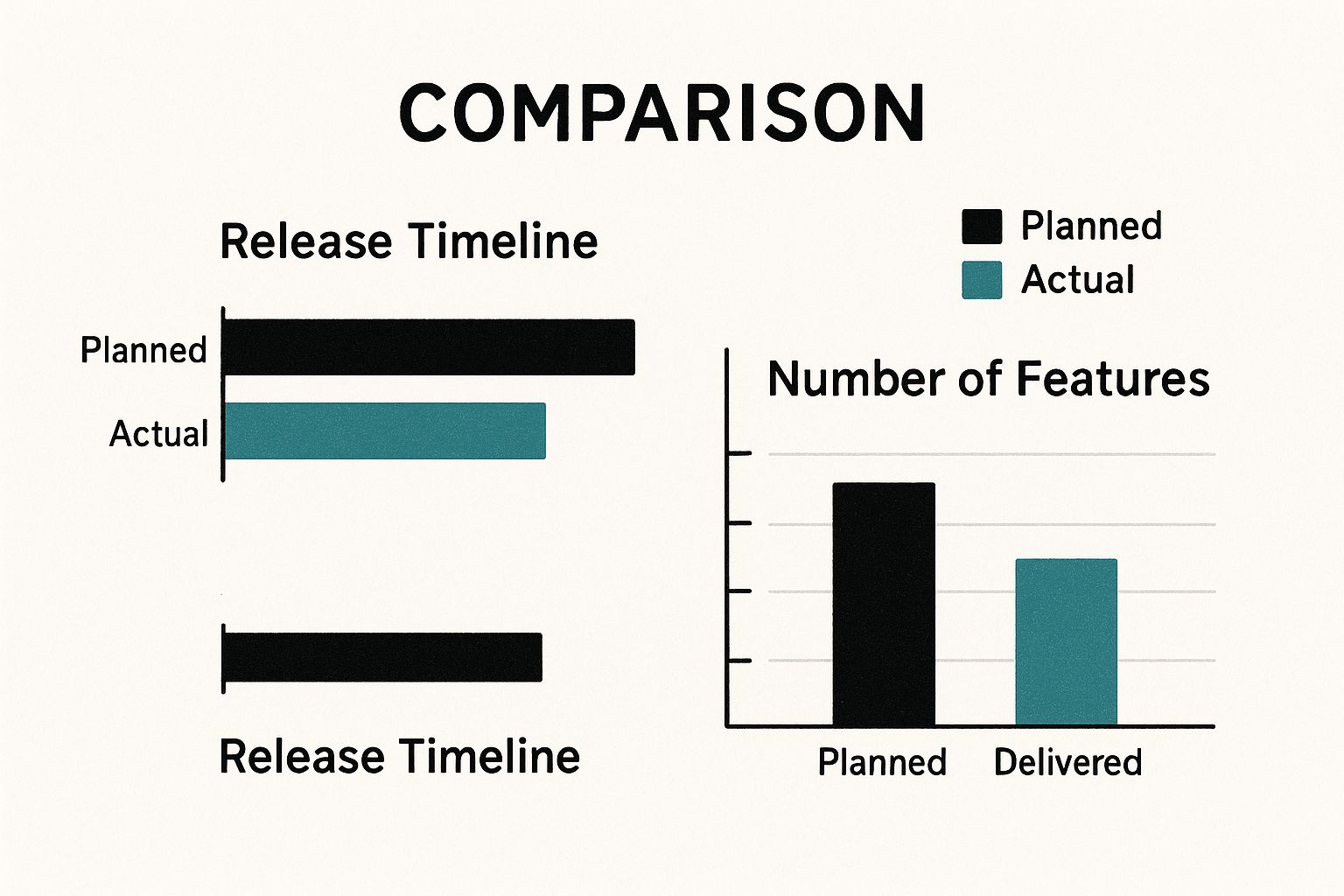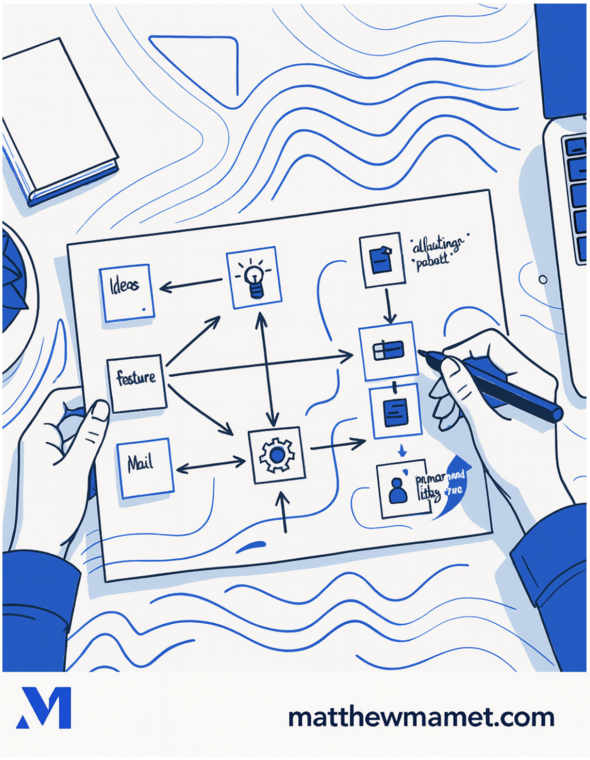Table of Contents
Moving Beyond a Basic Release Checklist
If your release process feels like you're just ticking off tasks on a list, you're missing the point. A simple checklist tells you what's done, but it completely fails to communicate the why behind the work. This is exactly where a real release planning template makes all the difference.
To get a handle on complex releases, you have to move beyond a simple to-do list and adopt a more robust framework. It’s a principle that applies to any complex project. Even looking at a well-structured event planning checklist template shows how a thought-out approach ensures nothing gets missed—a lesson that translates perfectly to shipping software.
Establishing the Core Pillars
The best templates I've seen are all built on four essential pillars. These are the components that transform a simple document into a strategic roadmap, creating clarity and alignment right from day one.
- Clear Objectives: What specific business goal or user problem is this release actually solving? This isn't about listing features; it's about defining what success looks like.
- Key Stakeholders: Who needs to be involved, kept in the loop, or consulted? Nailing this down—from the C-suite to customer support—prevents those awful last-minute surprises.
- Realistic Scope: What features are in? And just as critical, what features are out? A clearly defined scope is your single best defense against the dreaded scope creep.
- High-Level Timeline: What are the major milestones and the target launch date? This sets clear expectations and is fundamental for allocating resources effectively.
A quick-reference table can help keep these core elements front and center for your team.
Ready to drive more growth & achieve bigger impact?
Leverage my 25+ years of successes and failures to unlock your growth and achieve results you never thought possible.
Get StartedCore Components of an Effective Release Plan
This table summarizes the essential elements every release planning template should include to ensure clarity and alignment across your team.
| Component | What It Answers | Why It's Critical |
|---|---|---|
| Objectives | Why are we building this? What problem does it solve? | Aligns the team on a shared purpose beyond just shipping features. |
| Stakeholders | Who needs to be involved, informed, and consulted? | Prevents communication gaps and ensures buy-in from all parties. |
| Scope | What's in and what's out for this release? | Protects against scope creep and keeps the project focused. |
| Timeline | What are the key milestones and target launch date? | Sets realistic expectations and guides resource planning. |
Having these components locked down is non-negotiable for a smooth release.
A well-structured plan is less about imposing rigid rules and more about creating a shared understanding of the destination and the path to get there. It’s the single source of truth that keeps everyone rowing in the same direction.
This isn't just theory. Industry leaders like Microsoft and Atlassian build their entire release processes around these core ideas. Microsoft’s templates are heavily focused on vision, goals, scope, and schedule. Atlassian, for its part, really hammers home the "why, who, and when" to make sure stakeholder analysis and scheduling get the attention they deserve. In fact, companies that adopt these more formal frameworks see an average 30% improvement in on-time releases.
By building your plan on this kind of solid foundation, you shift from reactive task-juggling to proactive, strategic execution. For a concrete look at how these pieces all fit together, you can review a sample software release plan to see these principles in practice. It’s an approach that ensures your team isn't just shipping features—they're actually delivering value.
How to Customize Your Release Planning Template

A generic release planning template is just a starting point, never the final destination. The real magic happens when you shape it to reflect how your team actually works. A one-size-fits-all approach is a recipe for a document that gets ignored, simply because it doesn't fit your specific rhythm—whether you're running fast-paced agile sprints or managing a more traditional waterfall project.
The goal here isn't to create a rigid checklist that adds friction. It's to forge a living document that genuinely serves your team. That means being deliberate about what you add, what you remove, and how you adapt every single section to your reality.
Tailoring for Your Methodology
The first thing you need to do is align the template with your team's core development methodology. It sounds obvious, but you'd be surprised how many teams skip this. The needs of an agile team are worlds away from a team following a waterfall model.
Ready to drive more growth & achieve bigger impact?
Leverage my 25+ years of successes and failures to unlock your growth and achieve results you never thought possible.
Get StartedFor an Agile or Scrum team, the template needs to be lightweight and flexible. It’s less about exhaustive detail and more about a snapshot of the work. You should have clear fields for:
- Story Points: To quantify the effort for each task or feature.
- Team Velocity: This is your key metric for forecasting how much work you can realistically get done in a sprint.
- Sprint Goals: A high-level summary of what each sprint is trying to achieve, connecting the day-to-day work back to the bigger picture.
On the other hand, a Waterfall team needs something more structured and sequential. Your template will have a completely different feel. Key sections would include detailed phase gates, links to comprehensive upfront documentation, and firm sign-off checkpoints for each stage of the project.
The most effective template is a mirror reflecting your team's process. If your team lives and breathes sprints, your template should too. If you operate in distinct phases, that structure must be the backbone of your plan.
Integrating Cross-Functional Checkpoints
Modern software development is a team sport, and it extends way beyond just the engineering team. A truly useful release plan has to bridge the gaps between different departments. This is where you add sections that ensure smooth handoffs and prevent that last-minute chaos we all know too well.
Let's imagine a mobile app team planning a major feature update. A generic template would be useless. Their customized version, however, might include specific sections like:
- Marketing Handoff Checklist: This details everything the marketing team needs to get their campaigns ready, like final screenshots, app store copy, and key messaging points.
- QA Sign-Off: A formal checkpoint where the QA lead confirms all critical test cases have passed and the build is stable. No ambiguity.
- Customer Support Readiness: A spot to track the creation of help desk articles and make sure support agents are trained on the new functionality before it goes live.
Adding these checkpoints turns the template from a simple engineering plan into a holistic business tool. It's about proactive communication. For some surprising insights into structuring this kind of information clearly, it's worth seeing how principles from knowledge base creation can apply. Learning to Create Effective Knowledge Base Article Templates Today can give you a fresh perspective.
Ultimately, customizing your release plan is about solving problems before they happen. By anticipating the needs of different teams and building in the right metrics and checkpoints from the start, you create a document that builds alignment, slashes risk, and actually guides your release to a successful finish.
Integrating Your Plan with Agile and Scrum Workflows

A high-level release plan is a great start, but it’s worthless if it doesn't actually connect to the daily grind of your development team. Too often, these plans become outdated artifacts. For agile teams, the real trick is making your release plan a dynamic tool that lives and breathes within your Scrum ceremonies, not just a document that gathers digital dust.
The plan can't be some distant, abstract concept. It should be the north star during sprint planning. When the team is debating which user stories to pull into the next sprint, the release plan provides the strategic "why." It helps everyone answer the most important question: "Does this work actually move us closer to our release goals?"
Connecting Strategy to Sprints
To make this connection real, your release plan has to directly feed your backlog grooming sessions. As you prioritize the product backlog, you should constantly be cross-referencing your release milestones. This is what keeps your team focused on features that will deliver the most value for the upcoming release.
This simple habit transforms backlog grooming from a mechanical task-ranking exercise into a truly strategic activity. It's how you stop the team from getting lost in the weeds of low-impact work, keeping their eyes on the prize defined in your plan. If you're looking to tighten this process up, a practical guide to agile methodology for small teams can offer some great pointers.
Ready to drive more growth & achieve bigger impact?
Leverage my 25+ years of successes and failures to unlock your growth and achieve results you never thought possible.
Get StartedThe data backs this up. Scrum teams that use a release plan to guide sprint goals and backlog grooming see a 25% improvement in meeting their sprint objectives. The same teams also report a 20% drop in deployment errors—a huge win. For companies juggling multiple releases, using standardized templates has even been shown to boost resource allocation efficiency by 15%.
Keeping the Plan a Living Document
Here's where most teams fail: they treat the plan as a static document, created once and then promptly forgotten. To sidestep this common pitfall, you have to build a feedback loop that runs directly from your sprints back into the release plan.
Your release plan is only as valuable as its last update. It should reflect the reality on the ground, not the assumptions you made three months ago.
The sprint retrospective is the perfect place for this to happen. After every sprint, your team has fresh intel—on their actual velocity, on unexpected roadblocks, and on shifting priorities. This is your chance to update the plan.
- Adjust Timelines: If a sprint ran long, the overall timeline might need a dose of reality.
- Refine Scope: You might discover that a feature is way more complex—or less valuable—than you first thought.
- Update Risk Assessments: Retros are great for uncovering new risks that need to be logged and tracked in the plan.
This continuous feedback loop turns your release planning template into an accurate, dynamic forecasting tool. It also builds trust with stakeholders because you're giving them a transparent, up-to-date view of progress. To get a better handle on these iterative cycles, check out our guide on agile software development.
By truly embedding your plan into your agile workflows, you ensure it remains a powerful guide for every single sprint, not just a document that looks good on paper.
A great release plan is only half the story. Its real magic happens when it becomes a tool for communication—building the trust and buy-in you need from every single stakeholder.
After all, a plan that no one understands or believes in is just a document gathering dust. But a well-communicated plan? That’s a shared commitment.
The trick is to share the right information with the right people. Your template needs to be flexible enough to generate different views for different audiences. When it comes to stakeholder communication, one size definitely does not fit all.
Tailoring Your Message for Different Audiences
You wouldn't give the same pitch to your engineering lead and your CEO. They care about different things, they speak different languages, and they have completely different concerns. Your communication has to adapt.
- For Executives and Leadership: They need the 30,000-foot view, and they need it fast. Show them a high-level timeline, focusing on major milestones, the target release date, and how it all connects back to business goals. Keep it visual and link it directly to revenue or market share.
- For the Engineering Team: They live and breathe the details. Give them a granular view that breaks down features into epics and stories. This is where you highlight dependencies between tasks, clarify technical requirements, and discuss any potential technical debt.
- For Marketing and Sales: These teams are your go-to-market engine. They need to know what’s coming and when, so they can build the pipeline and craft the messaging. A GTM-focused view is crucial here, showing feature-complete dates and final asset delivery timelines.
This is where a modern release planning template really shines. It allows you to slice and dice the information effortlessly.
A plan isn't about broadcasting data; it's about building confidence. You do that by showing each stakeholder that their specific concerns have been considered and are addressed within the plan.
Making Your Release Planning Meetings Count
The release planning meeting is where your template truly comes to life. This isn’t a one-way presentation; it’s a negotiation. It’s an alignment session. Your job isn’t just to read off a list of features, but to guide a productive, and sometimes tough, conversation.
Ready to drive more growth & achieve bigger impact?
Leverage my 25+ years of successes and failures to unlock your growth and achieve results you never thought possible.
Get StartedExpect conflicting priorities. The sales team might be pushing for a feature that the engineering team knows is a huge technical risk. This is where you use your template as the single source of truth. Ground the discussion in reality by pointing to the data—the resource allocation, the dependencies, the risk scores—to drive a decision based on facts, not feelings.
Transparency is your best friend, especially with distributed teams. When everyone can see the plan, it cuts through the confusion and builds trust. We've seen that modern templates designed for clear task tracking and progress visualization can reduce release failures by up to 35%. Why? Because they force clear communication, which is more critical than ever in a remote-first world.
You can see how these templates drive real-world success on ChatPRD.ai.
Of course. Here is the rewritten section, crafted to sound like it was written by an experienced human expert, following all the provided guidelines.
Common Release Planning Mistakes to Avoid
Even the sharpest release planning template can't save a project that’s going off the rails. I’ve seen it happen time and again. It's almost never the template that fails; it's the process—or lack thereof—surrounding it. The first step to building a plan that can actually weather a few storms is knowing where the most common icebergs are hidden.
One of the biggest culprits? Wildly optimistic timelines. Teams fall into this trap all the time, either by underestimating the sheer complexity of the work or by bending to pressure from stakeholders. It sets everyone up for failure before the first line of code is even written. A close cousin to this mistake is failing to account for technical debt. Every shortcut and quick fix from past releases adds drag, and if your plan doesn't budget time to manage it, your timeline is pure fiction from day one.
This is the classic disconnect we’ve all felt between what was planned and what actually shipped.

As you can see, the gap between "planned" and "actual" isn't a small one. It's often a direct result of these common planning blunders—delivering fewer features than promised, and taking longer to do it.
Forgetting Dependencies and Scope
Another critical oversight is ignoring cross-functional dependencies. It's a classic blind spot. Your engineering team might be crushing their goals, but if marketing isn't ready with launch materials or the support team hasn't been trained on the new features, the release is dead on arrival. A solid plan has to map out these handoffs explicitly.
And then there's the ever-present danger of scope creep. It’s insidious. It usually starts with a "just one more thing" request that seems harmless enough. But without a firm process, these "minor" additions pile up, bloating the scope and completely torpedoing your schedule.
The most effective defense against scope creep is a formal change request process. It forces a tough but necessary conversation about trade-offs: if this new feature comes in, what feature gets pushed out? Or how does this impact our deadline?
By setting clear boundaries, you protect the release, keep the team focused, and manage everyone's expectations.
Poor Resource and Risk Management
Skipping a proper risk assessment is like sailing into a storm without checking the weather first. It’s just asking for trouble. What's the plan if a key developer gets sick? What happens if a third-party API goes down during deployment? A good release template has a section for risks, but it’s totally useless if you just leave it blank.
But it’s not just the big risks that get you; it’s the slow burn from sloppy management. I see these mistakes all the time, and they create a ton of unnecessary friction.
Before we get into the nitty-gritty, it's worth understanding why these issues pop up so often. They're rarely intentional; they're symptoms of a team moving too fast without clear processes. Here’s a breakdown of what to watch for.
Common Pitfalls in Release Planning
| Common Mistake | Why It Happens | How to Avoid It |
|---|---|---|
| Inconsistent Version Naming | Teams are in a hurry and use ad-hoc names like "Update 2" or "New Feature Build." | Establish a clear, semantic versioning convention (e.g., Major.Minor.Patch) and stick to it religiously. Make it part of your team's definition of done. |
| Forgetting to Link Work Items | It feels like extra admin work, so tickets in tools like Jira or Asana get left unlinked to the official release. | Make linking a mandatory step. Use your project management tool's features to automate this where possible and build it into your sprint review process. |
| Leaving Old Versions "Unreleased" | Once the code is live, the team moves on to the next fire, forgetting to officially mark the release as "shipped" in the system. | Create a simple post-release checklist. One of the items should be "Update release status in [Your Tool]." This cleans up the backlog and improves historical data. |
These little things might seem like minor administrative tasks, but their cumulative effect is huge. They erode clarity, make progress impossible to track accurately, and just make everyone's job harder. Nailing these details is a non-negotiable part of a successful launch. You can see this same principle reflected in any good product launch checklist, where meticulous tracking is key.
By actively sidestepping these common mistakes—from overly optimistic timelines to unmanaged scope and sloppy risk assessment—you turn your release plan from a simple document into a powerful tool for predictable, repeatable success.
Your Release Planning Template Questions Answered
When you roll out a new process like this, questions are going to pop up. That’s a good thing. It means your team is engaged and thinking through how to make it work. Let's tackle some of the most common ones I hear, moving past the theory and into practical, real-world advice.
Ready to drive more growth & achieve bigger impact?
Leverage my 25+ years of successes and failures to unlock your growth and achieve results you never thought possible.
Get StartedThe first question is always about timing: how often should we be updating this thing? The answer is simple. Your release plan has to be a living document, not some static artifact you create once and then forget about.
For any team working in an agile way, the best rhythm is to review and adjust the plan at the end of every sprint, usually during your retro. This cadence allows you to absorb what you've just learned, account for surprises, and recalibrate based on what your team is actually shipping.
What Is the Difference Between a Release Plan and a Roadmap?
This is a critical distinction because it gets right to the heart of strategic versus tactical planning. They’re absolutely related, but they serve very different masters and operate on completely different timelines.
A product roadmap is your high-level, strategic vision. Think 6, 12, or even 18 months out. It outlines the major themes and big bets that will drive the product forward. It answers the "what" and "why" on a grand scale.
A release plan, on the other hand, is all tactics and execution. It drills down into the "how" and "when" for a specific upcoming release, usually covering the next one to three months.
Think of it like this: the roadmap is the world map showing your ultimate destination. The release plan is the detailed, turn-by-turn navigation for the next leg of the journey.
Getting this distinction right keeps your conversations focused. You use the roadmap to get strategic buy-in from leadership, and you use the release plan to manage the immediate work with the team.
Do Small Teams Really Need a Formal Template?
Yes. Absolutely. I can’t stress this enough.
While a small, tight-knit team might feel like they can get by with informal chats and a shared understanding, a template provides an essential structure that prevents costly mistakes. It’s not about adding bureaucracy; it’s about being professional.
A lightweight release planning template forces you to:
- Surface Dependencies: It makes you think through those cross-functional handoffs you might otherwise miss until they’re already blocking you.
- Create a Single Source of Truth: When someone has a question, everyone knows exactly where to look. This kills so much confusion before it can even start.
- Defend Against Scope Creep: It establishes a clear, agreed-upon scope, giving you a powerful tool to push back on those "small" additions that lead to burnout.
Even a simple template that just covers goals, key features, target dates, and who’s responsible can professionalize your entire process. It builds a solid foundation for growth, ensuring good habits are baked in from the start, not bolted on later when things are already breaking.
Are you a product or software executive looking to refine your strategic planning and lead high-performing teams? Matthew Mamet offers specialized coaching that translates 25 years of experience into actionable playbooks for growth. Learn how to drive tangible results and unlock your full leadership potential at matthewmamet.com.
Ready to drive more growth & achieve bigger impact?
Leverage my 25+ years of successes and failures to unlock your growth and achieve results you never thought possible.
Get Started



